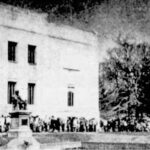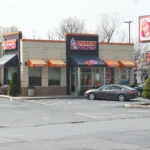“Hats off to him. When I walked by him after the seventh, I told him, ‘Good job, kid.'” — Norfolk manager Tony Tijerina
 The date: April 27, 2006
The date: April 27, 2006
The place: Harbor Park (Norfolk, Va.)
The situation: Sometimes, top prospects live up to their billing. Sometimes, they don’t. Before he officially was promoted to Triple-A on April 27, 2006, the jury was still out on Cole Hamels.
The numbers were inarguable as he prepared to make his Triple-A debut that night in Norfolk. He opened the 2006 season at low-Class A Lakewood and allowed one run in 5 2/3 innings before getting what seemed like a more permanent assignment to high-Class A Clearwater. And, Hamels dominated in his two starts there, too. Combined between those two stops, he allowed five runs and struck out 32 in 26 innings.
The lead-in: Desperate for starting pitching — John Leiber, Ryan Madson and Gavin Floyd, all in the Phillies rotation, had ERAs near or above 8.00 at the time — and looking to contend in the National League East, the Phillies went for broke. They promoted Hamels from Class A to Triple-A, to challenge him. To see if he was big-league ready. To see if he was an option.
The Norfolk Tides, the team that would finish dead last in the International League in batting average and OPS that season, had what turned into the unenviable task of showing Hamels what Triple-A ball is really like.

COLE HAMELS delivers a pitch in his only start for the Red Barons on May 7, 2006. TIMES SHAMROCK PHOTO
The moment: The left-hander dominated the Tides from the outset.
He changed speeds, keeping Tides hitters off-balance with an 88 mph fastball that he could also dial up to a whopping 94. He worked both sides of the plate. He worked up and down. When they were looking for fastballs, Hamels got them flailing at change-ups. He’d bury his breaking ball into the dirt when he wanted to, paint it on the corners when he wanted to.
“He had us out on our front foot a few times,” said Chris Basak, the Norfolk shortstop who would later go on to play for Scranton/Wilkes-Barre during the Yankees years.
Norfolk had little chance. In seven innings, Hamels threw 99 pitches and struck out a whopping 14 batters. Every batter in the Tides order fanned at least once. Cleanup man Juan Tejada went down three times. Three others struck out twice.
He allowed only three hits. Basak had two, one a double. But there were precious few chances for the Tides that night. Hamels didn’t issue a single walk.
All in all, it wasn’t bad for a first try in Triple-A. Hamels’ 14 strikeouts that night still stand as the Scranton/Wilkes-Barre record for strikeouts in a game by a southpaw. Right-hander Joel Bennett’s 15-strikeout performance against Buffalo exactly seven years earlier is still the only single-game performance that ranks better.
HISTORY BEHIND THE MOMENT
 It’s difficult to believe, because Hamels’ brief Triple-A career after that domination of Norfolk became the stuff of legends. But he was far from the biggest pitching prospect ever to suit up for the Red Barons.
It’s difficult to believe, because Hamels’ brief Triple-A career after that domination of Norfolk became the stuff of legends. But he was far from the biggest pitching prospect ever to suit up for the Red Barons.
In fact, that season, he opened as the No. 68 prospect in the game, according to Baseball America. Which meant, he wasn’t even the biggest prospect in the ballpark that night. Tides outfielder Lastings Milledge, who ranked No. 9 in the game according to the magazine, went 0 for 3.
But Hamels, a former first-round draft pick who missed almost all of 2005 after suffering a hand injury in a bar fight, went on a sterling run with the Red Barons.
He might have been even better in his second outing, throwing a complete-game, two-hit shutout against Richmond, in which he fanned 12.
“I thought it was Steve Carlton pitching against us,” Richmond manager Brian Snitker, currently the Atlanta Braves’ skipper, said after that one.
His first start at Lackawanna County Stadium on May 7 turned into his only one, even if it statistically was his worst Triple-A outing. Of course, he allowed just one run on five hits in seven innings, walking one and striking out 10. But, still…
“He’s special,” Red Barons catcher and current Phillies coach Dusty Wathan said. “I’ve been in the minor leagues for 13 years, and he’s one of the best — if not the best — I’ve ever caught.”
“I think I feel pretty comfortable,” Hamels joked with after the game with reporters, many of whom wanted to know if he felt close to being able to contribute to the Phillies rotation. “But that’s all up to you guys.
“What do you think?”
Just a few days later, the Phillies called him up. For good.
He went on to one of the most solid careers of any pitcher in the bigs over the last decade-plus. He has won 159 career games with a 3.40 ERA for the Phillies, Rangers and Cubs. He won the NLCS and World Series MVP awards for the Phillies during their magical 2008 season, and he went to four All-Star games.
Hamels’ performances were among the highlights of the 2006 season, the last of the Red Barons era, and he remains one of the last links to the former Phillies farmhands in the major leagues. Only Hamels and Yankees pitcher J.A. Happ remain among active big leaguers who once suited up for the Red Barons.

Donnie Collins has been a member of The Times-Tribune sports staff for nearly 20 years and has been the Penn State football beat writer for Times-Shamrock Newspapers since 2004. The Penn State Football Blog covers Nittany Lions, Big Ten and big-time college football news from Beaver Stadium to the practice field, the bowl game to National Letter of Intent Signing Day. Contact: dcollins@timesshamrock.com; 570-348-9100 x5368; @DonnieCollinsTT


